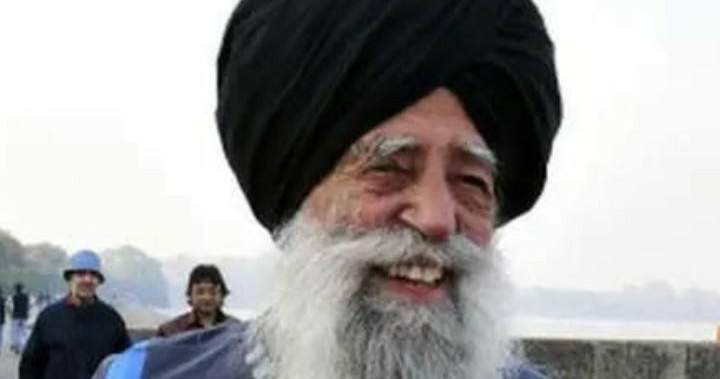I still remember how the crowd fell silent as Fauja Singh crossed the finish line at the Toronto Waterfront Marathon in 2011. The autumn sun caught the white of his beard as he raised his arms, not in triumph, but in gratitude. At 100 years old, Singh had just become the oldest person to complete a marathon.
“When I run, I talk to God,” Singh told me through his translator when I interviewed him years later. “My feet move, but it is something else pulling me forward.”
Standing barely five feet tall with a slight frame, Singh defied everything we think we know about physical endurance and aging. The centenarian runner, who became an international sensation after completing the Toronto marathon, passed away this March at 113. But his legacy – particularly in Toronto’s running and South Asian communities – continues to inspire a movement bridging cultural heritage and physical wellbeing.
Born in Punjab, India in 1911, Singh didn’t begin running until age 89, after moving to England following his wife’s death. What started as a way to combat depression became his pathway to international acclaim. His unexpected journey to Toronto would transform both his life and the city’s athletic landscape.
“Toronto became special to him,” explains Harmander Singh, his former coach and longtime friend. “The people embraced him here in a way that validated what he was trying to show the world – that age is just a number.”
Singh’s 2011 Toronto marathon finish catapulted him to global fame, but according to Canada Running Series founder Alan Brookes, his impact went far beyond the record books. “Fauja’s participation completely transformed our event’s demographics,” Brookes noted in a recent interview. “Before him, we had very little participation from South Asian communities. After 2011, we saw a 45% increase in runners identifying as South Asian.”
Data from Running Room Canada supports this trend, showing that participation in organized running events among South Asian Canadians doubled between 2011 and 2015 across major Canadian cities, with Toronto leading the surge.
Jagdeep Singh, who founded the Sikh Runners Club of Ontario in 2012, credits Fauja directly for his organization’s existence. “Before seeing Fauja run in Toronto, many in our community viewed running as something outside our cultural practice,” he explained during a community memorial event last month. “Now we have over 200 members who run together weekly, and many have completed the same marathon that Fauja did.”
The impact extends beyond just running statistics. Research from the University of Toronto’s Faculty of Kinesiology found that South Asian Canadians who cited Singh as an inspiration reported higher levels of physical activity and stronger connections to their cultural identity compared to those unfamiliar with his story.
What made Singh’s achievement so remarkable wasn’t just his age, but how he approached running as a spiritual practice rather than a competitive sport. He never learned to read, didn’t use sophisticated training technology, and followed a simple vegetarian diet. His consistent message was about the joy of movement rather than victory.
Dr. Sarabjeet Chaggar, a sports medicine specialist at Women’s College Hospital, believes Singh’s approach offers valuable lessons about sustainable fitness. “What we’re learning about longevity and exercise aligns perfectly with Singh’s intuitive approach,” she explains. “Consistent, moderate activity that brings joy rather than strain is precisely what current research recommends for healthy aging.”
When I visited Singh’s running club in Brampton last week, I met Kulwinder Kaur, 72, who took up running at 65 after seeing Singh at a community event. “If he could run at 100, I had no excuse at 65,” she told me, adjusting her running shoes. “Now I’ve done three half-marathons. My grandchildren think I’m a superhero.”
This ripple effect is precisely what race organizers hoped for when they first invited Singh to Toronto. Canada has one of the largest Sikh populations outside India, with nearly 300,000 living in the Greater Toronto Area according to Statistics Canada. Singh’s visibility helped bridge cultural divides within the running community while providing powerful representation.
“He showed us that our traditions and modern Canadian life don’t have to conflict,” explains Parminder Gill, executive director of Punjabi Community Health Services. “Many seniors in our community now see physical activity as compatible with their cultural identity rather than separate from it.”
The Toronto Waterfront Marathon has permanently honored Singh by naming the final kilometer of the race “Fauja Singh Lane,” and established the Fauja Singh Diversity Award that provides race entries to underrepresented communities.
Perhaps most telling of Singh’s lasting influence is how he’s remembered by those who knew him. Not for his world records or the endorsement deals that came later, but for his humility and joy.
“He would always say, ‘Why would I stop when I can still move?'” recalls Harmander Singh. “That was his philosophy – keep moving forward with gratitude, regardless of age or circumstance.”
As Toronto prepares for this year’s marathon in October, organizers expect record participation from South Asian runners, many wearing yellow turbans in Singh’s honor. His legacy reminds us that sometimes the most revolutionary act is simply to keep going when others expect you to stop.
In a world obsessed with youth and quick results, Fauja Singh showed us a different path – one measured not in minutes or kilometers, but in the joy found along the way.






